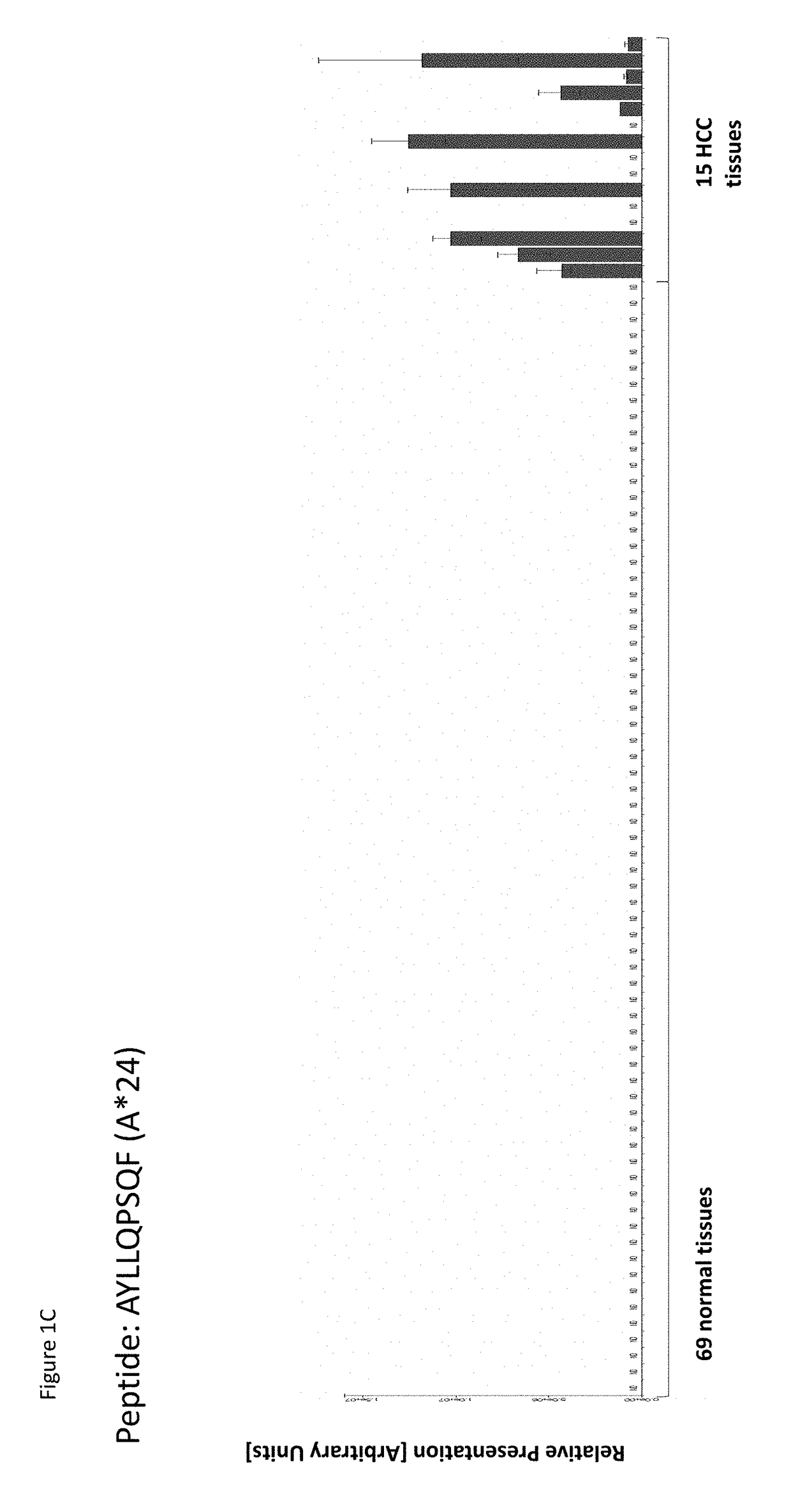Peptides and combination of peptides for use in immunotherapy against hepatocellular carcinoma (HCC) and other cancers
a technology of hepatocellular carcinoma and immunotherapy, which is applied in the field of immunotherapy of cancer, can solve the problems of increasing the risk of cancer development, poor overall prognosis of patients with hcc, and limited therapeutic options for advanced non-resectable h
- Summary
- Abstract
- Description
- Claims
- Application Information
AI Technical Summary
Problems solved by technology
Method used
Image
Examples
example 1
Identification and Quantitation of Tumor Associated Peptides Presented on the Cell Surface
Tissue Samples
[0575]Patients' tumor tissues were obtained from Universitätsklinik für Allgemeine, Viszeralund Transplantationschirurgie, Tübingen, Germany; Istituto Nazionale Tumori “Pascale”. Molecular Biology and Viral Oncology Unit, Via Mariano, Naples, Italy; Bio-Options Inc., Brea, Calif., USA; ProteoGenex Inc., Culver City, Calif., USA; Asterand Europe, Royston Herts, United Kingdom. Written informed consents of all patients had been given before surgery. Tissues were shock-frozen immediately after surgery and stored until isolation of TUMAPs at −70° C. or below.
Isolation of HLA Peptides from Tissue Samples
[0576]HLA peptide pools from shock-frozen tissue samples were obtained by immune precipitation from solid tissues according to a slightly modified protocol (Falk, K., 1991; Seeger, F. H. T., 1999) using the HLA-A*02-specific antibody BB7.2, the HLA-A, -B, -C-specific antibody W6 / 32, CNB...
example 2
Expression Profiling of Genes Encoding the Peptides of the Invention
[0582]Over-presentation or specific presentation of a peptide on tumor cells compared to normal cells is sufficient for its usefulness in immunotherapy, and some peptides are tumor-specific despite their source protein occurring also in normal tissues. Still, mRNA expression profiling adds an additional level of safety in selection of peptide targets for immunotherapies. Especially for therapeutic options with high safety risks, such as affinity-matured TCRs, the ideal target peptide will be derived from a protein that is unique to the tumor and not found on normal tissues.
RNA Sources and Preparation
[0583]Surgically removed tissue specimens were provided as indicated above (see Example 1) after written informed consent had been obtained from each patient. Tumor tissue specimens were snap-frozen immediately after surgery and later homogenized with mortar and pestle under liquid nitrogen. Total RNA was prepared from t...
example 3
UV-Ligand Exchange / Peptide Binding to HLA-A*02 and HLA-A*24
[0588]Candidate peptides for T cell based therapies according to the present invention were further tested for their MHC binding capacity (affinity). The individual peptide-MHC complexes were produced by UV-ligand exchange, where a UV-sensitive peptide is cleaved upon UV-irradiation, and exchanged with the peptide of interest as analyzed. Only peptide candidates that can effectively bind and stabilize the peptide-receptive MHC molecules prevent dissociation of the MHC complexes. To determine the yield of the exchange reaction, an ELISA was performed based on the detection of the light chain (β2m) of stabilized MHC complexes. The assay was performed as generally described in Rodenko et al. (Rodenko B, Toebes M, Hadrup S R, van Esch W J, Molenaar A M, Schumacher T N, Ovaa H. Generation of peptide-MHC class I complexes through UV-mediated ligand exchange. Nat Protoc. 2006; 1(3):1120-32).
[0589]96 well MAXISorp plates (NUNC) were...
PUM
 Login to View More
Login to View More Abstract
Description
Claims
Application Information
 Login to View More
Login to View More - R&D
- Intellectual Property
- Life Sciences
- Materials
- Tech Scout
- Unparalleled Data Quality
- Higher Quality Content
- 60% Fewer Hallucinations
Browse by: Latest US Patents, China's latest patents, Technical Efficacy Thesaurus, Application Domain, Technology Topic, Popular Technical Reports.
© 2025 PatSnap. All rights reserved.Legal|Privacy policy|Modern Slavery Act Transparency Statement|Sitemap|About US| Contact US: help@patsnap.com



